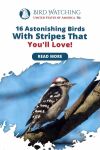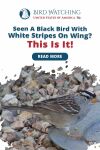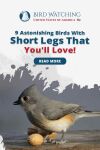
What’s This Post About?
Did you recently come across a spectacularly striped bird during your birding experience? Or are you wondering what little striped bird was grazing around in your backyard, hopping around, looking for food, during your morning stroll?
Well, there are quite a few striped bids out there, with splendidly contrasting stripes of different colors and hues across the spectrum. While some of them have vivid stripes, others may have faded inconspicuous stripes. Keep an eye out for these birds as they add a hint of visual in your backyard!
There are many birds with stripes. Some popular ones include Killdeer, Chipping sparrow, Lark sparrows, Black and white warbler, Yellow-rumped warbler, Downy Woodpeckers, Red-bellied woodpecker, American goldfinch, Northern mocking bird, Black-capped chickadee, House wren, and House finch.

Birds With Stripes
If you’re intrigued by several striped birds you may have come across and wonder how these birds add an immaculately beautiful touch to the natural environment, continue reading on.

Let’s get onto discovering several striped bird species that may make their way into your backyard.
| Names | Scientific Names |
|---|---|
| Killdeer | Charadrius vociferus |
| Chipping sparrow | Spizella passerina |
| Lark sparrows | Chondestes grammacus |
| Black and white warbler | Mniotilta varia |
| Yellow-rumped warbler | Setophaga coronata |
| Downy Woodpeckers | Picoides pubescens |
| Red-bellied woodpecker | Melanerpes carolinus |
| Ameican goldfinch | Spinus tristis |
| Northern mocking bird | Mimus polyglottos |
| Black-capped chickadee | Poecile atricapillus |
| Bewick’s wren | Thryomanes bewickii |
| House finch | Haemorhous mexicanus |
| Common starling | Sturnus vulgaris |
| White-breasted nuthatch | Sitta carolinensis |
| Indigo Bunting | Passerina cyanea |
| Northern Flicker | Colaptes auratus |
1. Killdeer

Killdeer is a shorebird that you can see without having to go to the beach. They are tawny birds that run across the ground in sprints. They have brown patterned plumage with several stark black stripes running across its face right above its eye, neck, and upper part of its chest.
They are a treat to look at, especially if you enjoy watching unusual birds. Unfortunately, these birds are not big fans of feeders; therefore, they don’t visit backyards, but if your neighborhood has open, expansive, cultivated fields or lawns, then you might find them spurting around your property.
Key features to look out for:
- The size is around 7.9-11 inches
- Large round head
- Slender and lanky
- Short bill
Fun Fact
Killdeer put on a ‘broken wing act’ in which they pretend to be suffering from a broken wing as they lead the predator away from their young.
2. Chipping Sparrow

This bird has a crisp look to it with a reddish-brown cap that provides a beautiful pop of color, making it easier for bird watchers and other birds to identify them.
They have white under feathers and many brown hues, especially on the upper part of their body, with dark brown stripes running down their wings, separating each of their feathers.
There’s a big horizontal stripe across their face, which is very prominent if you pay close attention to it. You can easily find these birds in all the states of the U.S.
Watch for small flocks of chipping sparrows grazing on open grounds of your backyard, especially the ones near trees and shrubs. They are perfect backyard guests, so make sure your bird feeders are full because this species often visits the feeders.
Key features to look out for:
- Size is 5-6 inches
- Frosty under-parts
- Black stripe through the eye
- Rusty crown
- Darkly striped upperparts
Fun Fact
Chipping sparrows need to consume a total of two pounds of seeds throughout winter to survive.
3. Lark Sparrows

They are small dusty-colored birds with a boldly striped face pattern on both the face and its wings. In addition, they have white under feathers that fade into the brown part of their upper body.
Much like chipping sparrows, lark sparrows also have dark brown stripes on their bodies’ upper part, including their wings.
These birds are common across the U.S. and breed commonly in North-Central Utah, Southwestern Montana, Northern and Southwestern Wyoming, Western Nebraska, and Southeastern Colorado.
In winters, lark sparrows are found along the coast of California and the lower Colorado River valley. They prefer grasslands and shrubbery, farms, roadsides, and pastures.
Key features to look out for:
- The size is 5.9-6.69 inches
- The facial pattern is rufous, black, and white
- Dark-streaked brown back
- White underparts
Fun Fact
Lark sparrows usually take over either mocking bird’s or thrasher’s nests instead of building their own.
4. Black and White Warbler

As the name suggests, the black and white warbler is covered in stark black and white stripes, making the bird look two times more interesting than any other bird. The colors spread from the beak to its chin and run down to its tail.
These birds prefer summer habitats which is why they are found in abundance in North and Southern America, and given their migratory nature, they migrate to the west.
If you have big trees, then they may appear in your backyard, especially if you have bugs in there too!
Key features to look out for:
- The size is 4.3-5.1 inches
- Bold black and white stripes
- Slightly down-curved bill
- Short neck
5. Yellow-rumped Warbler

Yellow-rumped Warbler is a stunning bird species with evident streaks in its feathers running down to its tail. Much like the sparrow, the feather in its wings looks as though each stripe separates them. The pattern coupled with the yellow-blotted chin and sides of its body adds to the overall appeal of the bird.
They are primarily found in conifer forests, open woods, bushes, shrubs, thickets, gardens, and even sometimes beaches. If your neighborhood or your backyard has a lot of trees, then you can expect these little hoppers to visit your backyard in search of food.
Key features to look out for:
- Its size is 4 ½ to 5 inches
- White underparts
- Black streaks on the back
- Sharp bill
- Yellow blots on its body and yellow tail patches
6. Downy Woodpeckers

The hyperactive little downy woodpecker is a familiar sight in the states. With a little red blot on the back of its head and a few streaks running across its face, it is a pleasant guest to have in your backyard. It’s a chirpy little bird.
Downy Woodpeckers love open evergreen woods, deciduous trees, weedy or bushy edges, but they may also be found in a different range of settings, including parks, vacant lots, and backyards.
Key features to look out for:
- Their height ranges from 5.5 to 6.6 inches
- Red nape with their head striped black and white
- Short bill
- White underparts
- Black back with white spots
7. Red-bellied Woodpecker

Red-bellied woodpeckers are an unforgettable sight, especially if you’ve come across them in your backyard or maybe spotted one flying around. They have a striking black back with white patches that make it look like they have uneven stripes. Isn’t that interesting?
All year, keep an eye out for this species if you live in the southeastern region of the U.S. During the spring and summer season, Red-bellied woodpeckers are pretty vocal and are heard singing often. They are a little territorial and defend their territory all year round.
Key features to look out for:
- Their size is 9.00 to 10.51 inches
- Distinctive patches that make it look like they have uneven stripes
- Redcap
- White under part
- Chisel-shaped bill
8. American Goldfinch

The American goldfinch is a handsome little bird and a common summer sight in the U.S. The males and females alike are colored in a subtler dusty brown, producing melodic and wistful cries.
Females are duller in appearance and may be identified by their sharp, pointed tails, wing bars, and absence of striping.
This charming tiny finch, the state bird of Iowa, Washington, and New Jersey, is a frequent visitor to feeders. Flocks of goldfinches swarm in weedy fields and at feeders during winters. So if you are living in the U.S, especially in the East, then you can spot one with ease without having to put in much effort.
Key features to look out for:
- The size is 4.3 inches on average
- White streaks on wing bars
- Pointed conical beaks
- Pointed tail
- Yellow body with white patches
9. Northern Mocking bird

The northern mocking bird is an interesting bird species that looks as though it may be innocent and tiny, but in reality, they are a little more than just that. Their personality is a mix of being territorial, aggressive, and defensive.
Their muted gray upper body and white under part paired with amazing black wings and white patches make them look stunning.
They are found everywhere in various habitats where there are bushes, trees, desert scrubs, and old pasture. They love mimicking other birds, car sounds, doors and windows slamming, and other noises which they incorporate in their songs. They are a treat to have in your backyard.
Key features to look out for:
- Its size is 8-11 inches
- White under feathers
- Black pointed bill
- Gray upper body
- White patches on the wings
10. Black-capped Chickadee

It’s a round chubby bird with white cheeks extending back to nape, a black under-chin, and a black cap that looks more like a ski mask when looked at from afar.
They have white chest feathers that fade into pale brown color on their underbody. Their wings and upper body are a soft gray with white streaks running down their feathers.
This bird is well-known throughout the United States since it nests in every state. They live in matured forests, woods, swamp forests, drier forests, and urban settlements. Carolina chickadees frequent all birdfeeders located in close proximity to forested areas.
If you’re living in areas where they heavily reside and want to look at one, don’t hold back. Install appropriate bird feeders as soon as you can and invite these birds over to your backyard.
Key features to look out for:
- The size is 4.75 to 5.75
- They have a black cap and bib
- White cheeks
- Soft gray back
- Buffy white underparts
- Streaky wings
Fun Fact
It is one of the relatively few songbirds in the state that is completely non-migratory.
11. Bewick’s Wren

Bewick’s Wren is a familiar backyard bird; they are chubby birds with brown plumage, white stripe across their face, long sharp beak, and an upright horizontally striped tail. Their playful and bouncy nature adds a lively spark to backyards, city parks, and gardens.
These birds are widespread across the United States and are year-round residents in the western part of the country. They may be found in abundance in Texas, the Gulf Coast, and northern Florida.
You may come across them in your backyard if you live near chaparral-covered hills, woods, oak trees, mixed forests, and desert scrubs. Make sure you install suitable feeders to make your backyard more inviting to them. Consider purchasing the Nature’s Way Tray Bird Feeder that is loved by many wrens.
Nature's Way Bird Products CWF3 Cedar Platform Tray Bird Feeder
Crafted from insect and rot resistant premium cedar with a water-based protective stain
12. House Finch

House finches are small-bodied finches with large beaks and long, flat heads. They have brown streaked feathers and back; the streaks run down to their tail. Males usually have a rosy red tint around the face area and upper breast. The females are very plain in comparison and have streaks all over their bodies.
They are cheerful and chirpy, found over North America in urban parks, backyards, lawns, urban regions, farms, and open forests. You may find house finches in the western United States, where they live in deserts, grasslands, chaparral, and open woodlands.
Key features to look out for:
- The size is 5.1-5.5 inches
- Large bills
- Streaky brown wings and underbody
- Notched tail
- Rosy red around face and upper chest on males
- Blurry streaks all over a female’s body
13. Common Starling

Common starling or European starlings are found year-round in America. They are black birds with bright yellow pointed bills and short tails.
They are usually known for their aggressiveness around other birds but are still dazzling as ever. Their plumage is dark and glossy, making it look as though they have streaks on their feathers.
They’re commonly found in Northern cities and towns, lawns, parks, and squares, except in the far north during the winter. They create boisterous groups in the fall, wandering in search of food and resting spots. Starlings can live in any habitat type, but they prefer the ones that people inhabit.
Key features to look out for:
- The size is 8.5 inches
- Glossed feathers
- Wings have a highlight of green and purple
- Yellow beak
- Short tails
Fun Fact
Starlings are impressive mimics, they can easily imitate the calls or songs of other birds, car alarms, door slams, and even mechanical sounds.
14. White-breasted Nuthatch

It’s an angry-looking bird with a black stripe running up its face to the nape of its neck. Because of the pattern on the edge of its eye, it looks like it’s wearing eyeliner. The upper body is a soft gray with black-streaked wings and white underparts.
White-breasted Nuthatches love running along the branches of mature trees. In the winter, they can be seen making tiny flocks with chickadees.
The White-breasted Nuthatch may be found in a wide range of vegetation types, from the woodlands of East to half-open, semi-dry areas in the Mountains. These birds can be found anywhere as long as there are mature deciduous and mixed coniferous trees.
Key features to look for:
- The size is 5.1-5.5 inches
- Gray on the back
- Striped feathers
- Whiteface and frosty underparts
- Seen probing into tree trunks
Did You Know?
Nuthatches are the only species that can walk both up and down a tree.
15. Indigo Bunting

As the name suggests, indigo bunting is a beautiful songbird found in abundance across parts of the East. The males in this species are sighted more than females, and that is maybe because their color is flashier than those of females, which makes them easier to spot.
In the summertime, look for indigo buntings near country highways, when they regularly sing for hours on telephone lines or woodland areas.
During migration, vast flocks of indigo buntings may be seen grazing in farmlands or on yards. Their brown feathers can be difficult to spot in the fall but watch for hints of blue in the wings and tail as a clue.
Key features to look out for:
- The male has a rich blue color
- Females are brown with buff-colored streaks and hints of blue on wings, tails, or rump
- Shiny silver bill
- Black stripes on wings down to its tail
- Dark eyes
Did You Know?
Indigo buntings are black; it is the diffraction of light through their feathers that make them appear blue.
16. Northern Flicker

The northern flicker is a common large woodpecker found across America. They have a slim, round head, downward curving bill, and a long tail.
They are brownish and have black spots covering their underpart. In addition, they have an uneven stripe-like pattern on their wings which makes them look super streaky from the back.
Northern birds prefer inhabiting spaces with open woods or forest edges but look for them on the ground as they love to forage there for seeds and insects.
Key features to look out for:
- The size is 12 inches long
- Dark back plumage
- Spotted breast
- Black necklace around the neck
- Unevenly striped back
- Red spot on the neck
- Bright yellow underwing and under the tail
Keep Reading!
This post talked about all the birds with stripes that you may spot in your backyard. Now that you’ve explored a vast range of species having stripes and even a striped plumage, it is much simpler to identify each bird with its distinctive features.
These striped birds may include Downy Woodpecker, Red-bellied Woodpecker, American Goldfinch, Northern Mocking Bird, Black-Capped Chickadee, House Wren, and House Finch.
Your greatest shot is to keep track of the species most likely to visit your yard and connect what you observe to what you know. If you are keen to learn more about birds, you must read this blog and jumpstart your bird-watching journey.
How to Start Bird Watching? A Fantastic Guide for An Enthralling Experience!
Is the trend of birdwatching catching onto you? Are you looking to amplify your birdwatching experience? Don’t miss out on reading this fantastic guide.

By David A. Swanson
Bird Watching USA
My name is David and I'm the the founder of Bird Watching USA! I started Bird Watching with My father-in-law many years ago, and I've become an addict to watching these beautiful creatures. I've learnt so much over about bird watching over the years that I want to share with the world everything I know about them!

David A. Swanson
Bird Watching USA
My name is David and I'm the the founder of Bird Watching USA! I started Bird Watching with My father-in-law many years ago, and I've become an addict to watching these beautiful creatures. I've learnt so much over about bird watching over the years that I want to share with the world everything I know about them!




![What?! Do Geese Really have Teeth?! [24 Awesome Pictures] Thumbnail](/assets/resized/img/posts/do-geese-have-teeth-100x150.jpg)


![What?! Do Geese Really have Teeth?! [24 Awesome Pictures] Thumbnail](/assets/resized/img/posts/do-geese-have-teeth_thumbnail-100x56.jpg)


